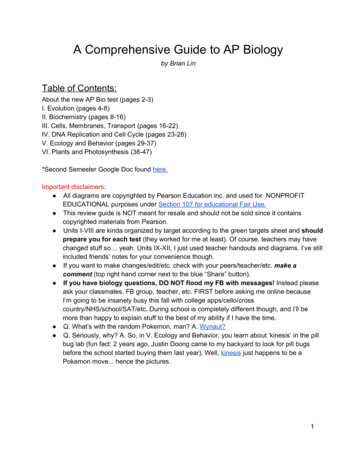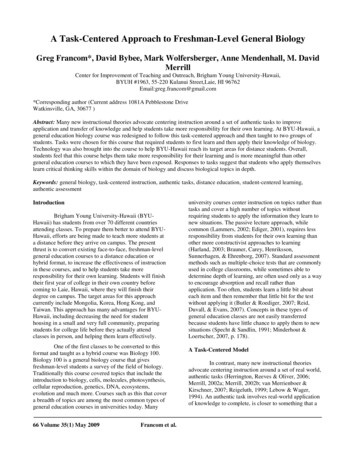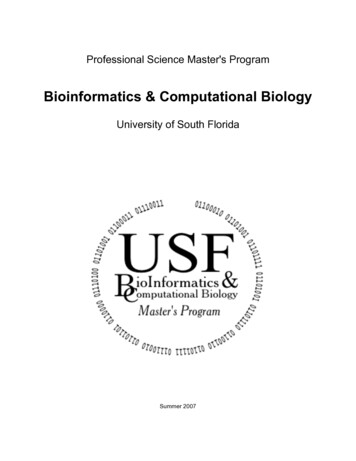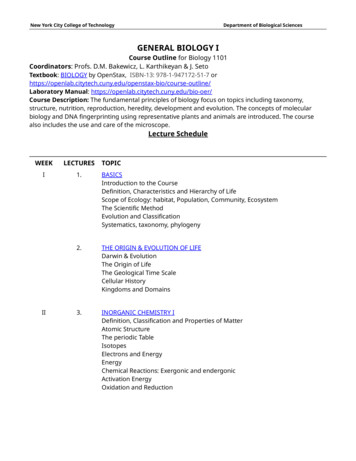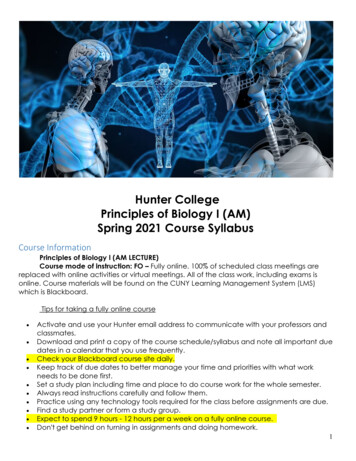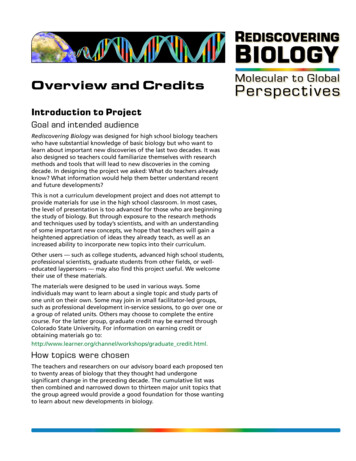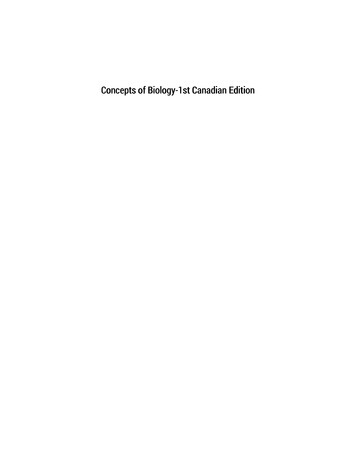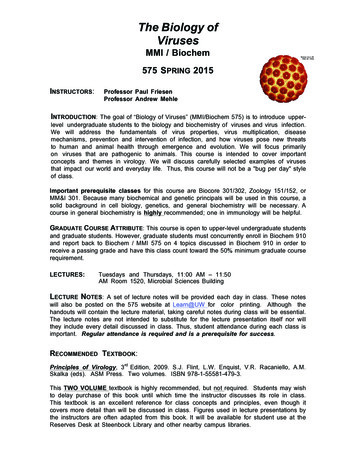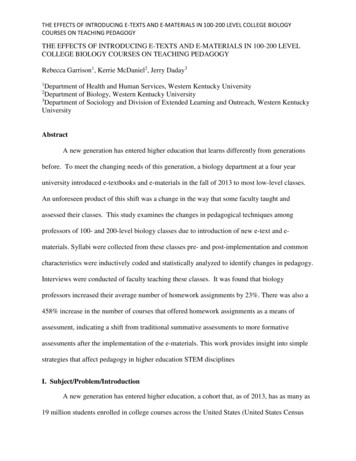
Transcription
THE EFFECTS OF INTRODUCING E-TEXTS AND E-MATERIALS IN 100-200 LEVEL COLLEGE BIOLOGYCOURSES ON TEACHING PEDAGOGYTHE EFFECTS OF INTRODUCING E-TEXTS AND E-MATERIALS IN 100-200 LEVELCOLLEGE BIOLOGY COURSES ON TEACHING PEDAGOGYRebecca Garrison1, Kerrie McDaniel2, Jerry Daday31Department of Health and Human Services, Western Kentucky UniversityDepartment of Biology, Western Kentucky University3Department of Sociology and Division of Extended Learning and Outreach, Western KentuckyUniversity2AbstractA new generation has entered higher education that learns differently from generationsbefore. To meet the changing needs of this generation, a biology department at a four yearuniversity introduced e-textbooks and e-materials in the fall of 2013 to most low-level classes.An unforeseen product of this shift was a change in the way that some faculty taught andassessed their classes. This study examines the changes in pedagogical techniques amongprofessors of 100- and 200-level biology classes due to introduction of new e-text and ematerials. Syllabi were collected from these classes pre- and post-implementation and commoncharacteristics were inductively coded and statistically analyzed to identify changes in pedagogy.Interviews were conducted of faculty teaching these classes. It was found that biologyprofessors increased their average number of homework assignments by 23%. There was also a458% increase in the number of courses that offered homework assignments as a means ofassessment, indicating a shift from traditional summative assessments to more formativeassessments after the implementation of the e-materials. This work provides insight into simplestrategies that affect pedagogy in higher education STEM disciplinesI. Subject/Problem/IntroductionA new generation has entered higher education, a cohort that, as of 2013, has as many as19 million students enrolled in college courses across the United States (United States Census
THE EFFECTS OF INTRODUCING E-TEXTS AND E-MATERIALS IN 100-200 LEVEL COLLEGE BIOLOGYCOURSES ON TEACHING PEDAGOGYBureau, 2013). This is the Net Generation, a population that learns contrarily to generationsbefore who studied by visiting libraries, using dial-up internet connections, and reading printmaterial. With the Net Generation comes what Jones, Ramanau, Cross, and Healing call a“generational shift [that] has consequences for approaches to learning because the newgeneration requires rapid access and quick rewards, is impatient with linear thinking and displaysa novel capacity for multi-tasking” (Jones et al., 2010, pg. 2).This shift can be seen in all aspects of life, but especially in the way they learn (Palfrey &Gasser, 2008). In the last 15 years, this has proven to be a problem as professors are being forcedto teach in a way that they themselves were not taught (Palfrey & Gasser, 2008). These studentshave grown up in an age where information is only a few internet searches away and now theydemand an education that is individualized and autonomous (Barnes et al., 2007; Palfrey &Gasser, 2008). To meet the needs of students, professors’ pedagogies must adapt to take mereinformation and turn it into acquirable knowledge in a form that Net Geners learn (Barnes et al.,2007).Professors of STEM courses, especially those of biology, have been called to improvetheir pedagogical content knowledge to develop a new system of teaching to improve education(Brewer & Smith, 2011). A change in pedagogy can be a daunting task, but is necessary to meetthe needs of the Net Geners that continue to enter colleges. This change has been recognized as adifficult task, but especially difficult for classes in the sciences (Henderson et al., 2011).Approaches that target this generation, interactive and active learning, are what the AmericanAssociation for the Advancement of Science believes is the kind of methodology that biologyprofessors need to develop in undergraduate courses (Brewer & Smith, 2011; Brownell &Tanner, 2012). College professors may know extensive content about their subject, but they
THE EFFECTS OF INTRODUCING E-TEXTS AND E-MATERIALS IN 100-200 LEVEL COLLEGE BIOLOGYCOURSES ON TEACHING PEDAGOGYmay not possess the skills or be aware of the teaching methodologies needed to transfer to theirknowledge to students and promote student learning and excellence (Jang, 2009). The concept ofmixing these ideals results in pedagogical content knowledge (PCK), or as Jang expresses it,“representation of concepts [and] pedagogical techniques ” (2011). In biology courses,professors resist pedagogical change because it is time consuming and “change” comes with theconnotation that professors are not teaching effectively (Brewer & Smith, 2011). This resistancecontributes to what Brownell and Tanner (2011) consider are the three main sources of delay inpedagogical modernization: lack of training, time, and incentives. If biology professors areexpected to learn how to teach in a way that they were not taught, it would take consistentfeedback and several trials; something they cannot simply learn in a short workshop (Brownell &Tanner, 2011). While there are no simple answers to this problem, interventions that shiftpedagogy in the teaching of biology at the college level with minimal effort are desirable.A biology department at a 4-year university recently shifted from using traditional textsto e-texts and e-materials in their introductory courses. This initiative to introduce an e-text forglobal use in 100- and 200-level courses in the biology department began as an attempt tostandardize content across professors, facilitate the transition for professors between courses, andto reduce the price of textbook costs for students. A side effect of this transition was a change inteaching pedagogy.This study evaluates pedagogical change that has occurred in the biology department at auniversity due to the introduction and implementation of e-textbook and e-materials in freshmanand sophomore-level undergraduate courses in an attempt to meet the needs of the NetGeneration. The study looks further at changes specifically in Human Anatomy and Physiology
THE EFFECTS OF INTRODUCING E-TEXTS AND E-MATERIALS IN 100-200 LEVEL COLLEGE BIOLOGYCOURSES ON TEACHING PEDAGOGYcourses, a subset of the biology courses, which has attempted to modernize a once verytraditionally taught course.II. Design/ProcedureThe central goal of this research was to evaluate if and how pedagogy has changed inintroductory biology courses after adopting and implementing e-materials. This wasaccomplished through content analysis of course syllabi and interviews with faculty members.The e-text and e-materials were implemented to the biology department in fall of 2013. Syllabifor the low-level biology courses were collected for a total of three years. A total of 150 syllabiwere collected pre-implementation, starting 2 years prior in the fall of 2011. Additionally, 104syllabi were collected for a year and half post-implementation, ending in spring of 2014.Together, 254 syllabi were collected for the analyses.After the 254 syllabi were collected from the school’s website, they were individuallynumbered and then analyzed for apparent themes. This was an inductive process, where coursesyllabi were initially read and examined by a single coder for items that would be appropriate forsubsequent coding and analysis. This reading and examination of course syllabi by the coderresulted in the development of eight main themes, including: Class name and section (ex: 131-001) Professor teaching the class Semester this class was taught Grade distribution of assignments (exams, quizzes, homework, and other) Total number of assignments (exams, quizzes, homework, and other) Form of text used (e-text vs traditional text) Other open education resources (OERs) used
THE EFFECTS OF INTRODUCING E-TEXTS AND E-MATERIALS IN 100-200 LEVEL COLLEGE BIOLOGYCOURSES ON TEACHING PEDAGOGY Type of tests, quizzes, and homework (online vs. traditional)These themes were expanded to 27 total items that were collected from each syllabus. Acodebook was created to specify rules on how the items in the syllabi should be coded. Thecodebook allowed for the further extraction of specific information from each of the 254 coursesyllabi. The coder read and examined each of the 254 course syllabi identified for this study, andentered relevant information on a corresponding coding sheet, each numbered to match thecorresponding numbered syllabus. A single coding sheet was generated for each course syllabus.A simplified coding sheet is shown in Table 1.Coding Sheet1. Class name### (Class) - ### (Section)2. Professor# (Corresponding with a professor)3. SemesterSemester, Year4. Percent of total grade in testsCalculated numerical value5. Percent of total grade in quizzesCalculated numerical value6. Percent of total grade in homeworkCalculated numerical value7. Percent of total grade in discussionCalculated numerical value8. Percent of total grade in otherCalculated numerical value9. Total number of testsNumerical value10. Total number of quizzesNumerical value11. Total number of homeworkNumerical value12. Total number of otherNumerical value13. Use of e-textAbsent 0, Present 1, Unclear 214. Use of e-text from McGraw Hill Absent 0, Present 1, Unclear 215. Use of e-text from otherAbsent 0, Present 1, Unclear 216. Use of traditional textAbsent 0, Present 1, Unclear 217. Use of a general video to teachAbsent 0, Present 1, Unclear 218. Use of a Tegrity video to teachAbsent 0, Present 1, Unclear 2
THE EFFECTS OF INTRODUCING E-TEXTS AND E-MATERIALS IN 100-200 LEVEL COLLEGE BIOLOGYCOURSES ON TEACHING PEDAGOGY19. Use of a class websiteAbsent 0, Present 1, Unclear 220. Use of other OERsAbsent 0, Present 1, Unclear 221. Use of Blackboard Absent 0, Present 1, Unclear 222. Use of online homeworkAbsent 0, Present 1, Unclear 223. Use of online homework from McGrawHill 24. Use of online homework from otherAbsent 0, Present 1, Unclear 225. Use of online quizzesAbsent 0, Present 1, Unclear 226. Use of online testsAbsent 0, Present 1, Unclear 227. Use of extra creditAbsent 0, Present 1, Unclear 2Absent 0, Present 1, Unclear 2Table 1. Coding SheetItems 4-8 in the coding sheet represented how much of the total grade for a single coursewas allotted to different forms of assessments, including: tests, quizzes, homework, discussion,and other. Items 13-27 in the coding sheet were common characteristics or resources that wereseen thematically throughout the syllabi. These characteristics were accounted for on the codingsheet as “present” or “absent” for each syllabus, which is clarified in the following Table 2:Description of Characteristics in the Coding Sheet#CharacteristicDescription13 E-textIncludes the general use of any online textbook14 E-text fromMcGraw Hill If item is present in syllabi, it is counted in both the general “etext” category and here15 Other E-textIf item is present in syllabi, it is counted in both the general “etext” category and here16 Paper textAny traditional textbook, can be offered alongside of e-text17 General videoVideos made by someone other than the professor18 Tegrity videosVideos professors have made of themselves teaching forstudents to access19 Class websiteAny additional website made specifically for given course
THE EFFECTS OF INTRODUCING E-TEXTS AND E-MATERIALS IN 100-200 LEVEL COLLEGE BIOLOGYCOURSES ON TEACHING PEDAGOGY20 Other OEROpen Educational Resource21 Blackboard An online learning management system which both professorsand students can access to post content, grades, assignments,etc.22 Online homeworkAny general homework to be completed online23 Online homeworkfromLearnsmart If item is present in syllabi, it is counted in both general“online homework” category and here24 Other onlinehomeworkIf item is present in syllabi, it is counted in both the general“online homework” category and here25 Online quizzesQuizzes completed on a computer, whether in class or a testingcenter26 Online testsTests completed on a computer, whether in class or a testingcenter27 Extra creditCan be a variety of options, has to be specifically stated as anextra credit optionTable 2. Description of Characteristics in the Coding SheetAfter the coding sheet and codebook were created, all syllabi were coded separately bytwo coders to ensure inter-coder reliability, represented by coders “A” and “B.” Their findingswere then compared to find the amount of error between the coders. Both sets of data (one fromeach coder) were analyzed in a computer software program, STATA, to generate acorresponding percentage of agreement and a kappa value for each characteristic that could bequantified numerically. The kappa value can range from 0.0 to 1.0; the closer the kappa value isto 1.0, the higher the relationship is between the two sets of data. Landis and Koch (1977, p165)further clarify the possible kappa values by dividing them into 5 categories. Inter-coderreliability for all characteristics had a Kappa value above .81 making the interpretation “almostperfect”.
THE EFFECTS OF INTRODUCING E-TEXTS AND E-MATERIALS IN 100-200 LEVEL COLLEGE BIOLOGYCOURSES ON TEACHING PEDAGOGYIn addition, faculty interviews were conducted to clarify e-text and e-materials use alongwith changes in pedagogy that resulted from this implementation. The interviewer was trained ininterview techniques, met with biology faculty and transcribed the conversation. Transcriptswere reviewed, summarized, and compared with syllabi data.III. Analysis/FindingsData collected from the syllabi were entered into a Microsoft Excel spreadsheet andanalyzed with IBM SPSS using two main statistical procedures, crosstabs and t-tests. Crosstabswere used to compare the presence or absence of course characteristics for syllabi preimplementation and post-implementation. Each crosstab showed the percentage of syllabi thathad a specific course characteristic pre- and post-implementation along with a Pearson chisquare statistic to test for significant differences between these two groups. An alpha of p .05was used to determine if there was a significant difference in the percentages of course syllabipossessing certain course attributes pre- and post-implementation (Figure 1&5).T-tests were conducted to compare the average number of assignments pre- and postimplementation (items 9-12 in Table 1) and to compare the grade distribution based onpercentages pre- and post-implementation (items 4-8 in Table 1). Given the continuous nature ofthese variables, t-tests were employed to compare these course attributes pre- and postimplementation rather than cross-tabs.Pre- and post-implementation totals and averages of each characteristic were compared toestablish significance using an independent sample t-test. Levene’s Test for Equality ofVariances is first used to determine if there is a significant difference in the variances of eachgroup with p .05 used as the threshold for significance. If the alpha for the Levene’s test was
THE EFFECTS OF INTRODUCING E-TEXTS AND E-MATERIALS IN 100-200 LEVEL COLLEGE BIOLOGYCOURSES ON TEACHING PEDAGOGYgreater than or equal to .05, equal variances are assumed and the two-tailed test listed in the firstrow of the IBM SPSS output is used to determine significance. However, if the Levene’s test hadan alpha of less than .05, equal variances are not assumed between the pre- and postimplementation groups for each course characteristic, and the two-tailed test listed in the secondrow of the IBM SPSS output was used to determined significance.Through inductive coding of course syllabi, fifteen characteristics were identified andcoded. These characteristics were compared pre- and post-implementation using cross-tabs todetermine percentages and level of significance across both groups.Additionally, t-tests were used to analyze the percentage of courses that utilize each formof assessment (tests, quizzes, homework, and other) pre- and post-implementation, averagenumber of each assessment per syllabi, and the amount of the total grade allotted to eachassessment. The characteristics marked with an asterisk (*) in the figures symbolize a significantresult with an alpha of p .05. This process and tests were completed first for all general biologycourse syllabi (Figures 1-4) and then repeated for findings specifically related to anatomy andphysiology course syllabi as a sub-set sample (Figures 5-8).The percentages in Figure 1 showed the presence of each characteristic on course syllabipre- and post-implementation. The darker bars represented the percentage of course syllabi preimplementation of e-text and e-material (before Fall 2013) and the lighter bars represented thepercentage of course syllabi after the implementation (Fall 2013 and after). If a coursecharacteristic was significantly different pre- and post-implementation, an asterisk (*) was listednext the attribute in Figure 1. The value above each bar was the raw score of the syllabi with thepresent characteristic. The raw score is especially interesting because the total number of syllabipre-implementation (150) was much larger than the total number of syllabi post-implementation
THE EFFECTS OF INTRODUCING E-TEXTS AND E-MATERIALS IN 100-200 LEVEL COLLEGE BIOLOGYCOURSES ON TEACHING PEDAGOGY(104). Most notable from Figure1 is the change in total number of syllabi that use general onlinehomework, specifically, Learnsmart . Before the implementation of the e-learning system, only19 syllabi showed any use of online homework, while post-implementation that had increased to82 syllabi. The presence of Learnsmart also increased drastically in syllabi, from 1 to 75.(84)* p .05Figure 1. Percentages of Present Characteristics in Biology Courses Pre- andPost-ImplementationAs the presence of e-text in syllabi increased, paper text significantly decreased from85.2% to 4.8%. The syllabi listing use of e-text other than from McGraw Hill significantlydecreased from 15.4% to 1% after the implementation. Use of general videos and Tegrity videos both decreased in syllabi, general video from 8.1% to 1.9% and the Tegrity videos from13.4% to 7.7%, but only general videos saw a significant relationship. Syllabi reporting use ofclass websites also significantly decreased from 6.7% to 0% and syllabi including other openeducation resources (OERs) from 14.1% pre-implementation to 3.8% post-implementation. Foronline homework, all three areas saw an increase with the new implementations, including onlinehomework in general, online homework through Learnsmart , and other online homework
THE EFFECTS OF INTRODUCING E-TEXTS AND E-MATERIALS IN 100-200 LEVEL COLLEGE BIOLOGYCOURSES ON TEACHING PEDAGOGYassignments. General online homework significantly increased in presence from 12.8% to78.8%. Also, online homework specifically from Learnsmart significantly increased from0.7% pre- to 72.1% post-, and other online homework included in syllabi from 12.2% to 17.3%.Many of the other online homework assignments came from professors posting additionalhomework on Blackboard , rather than a separate source. Online quizzes also saw change,though insignificant, and increased from 22.8% pre- to 28.8% post-. Online tests were alsoaffected as indicated by their increase from 30.2% to 37.5% in the syllabi.* p .05Figure 2. Percentage of Biology Courses that Utilize Each Form of AssessmentAssessmentThepercentage of syllabi that included tests, quizzes, homework, and other assignmentspre- and post-implementation are shown in Figure 2. Biology courses that listed homework as ameans of assessment significantly increased by 458% from 12% pre- to 67.3% postimplementation. Pre-implementation, 88% of the syllabi from general biology courses includedtests as a means of assessment and this decreased to 85%. The percent of syllabi that usedquizzes stayed constant from 36% pre- to 35% post-. Presence of other assessments in syllabidecreased from 34% to 19%, a 44% decrease.
THE EFFECTS OF INTRODUCING E-TEXTS AND E-MATERIALS IN 100-200 LEVEL COLLEGE BIOLOGYCOURSES ON TEACHING PEDAGOGY* p .05* p .05Figure 3. Average Number of Assignments in Biology CoursesFigure 4. Average Percentage Makeup of Grades in Biology CoursesFigure 3 shows the average number of assignments that were listed in the syllabi pre- andpost-implementation. The only significant finding was in the average number of homeworkassignments in a single syllabus, which increased from 10.06 to 12.33. Average number of testsdecreased from 4.03 pre- to 3.6 post-implementation; the average number of quizzes stayedalmost constant with 8.72 to 8.65; and other assignments average decreased from 7.1 to 5 pergeneral biology course.Figure 4 shows how professors, on average, distributed their grades as reflected on theircourse syllabi. Before the implementation, larger percentages of grades relied on tests,significantly decreasing from 80.56% to 67.72%. Percentage of total grade in other assignmentsalso significantly decreased from 28.8% to 16.35%. Percentage placed in quizzes, on average,also decreased from 31.65% to 24.05%. Percent in homework stayed almost completely the samefrom 22.4% to 21.8%. This data indicated a shift away from summative assessment as the solemethod of evaluation to include more formative assessments.A sub-study focusing specifically on Anatomy and Physiology 1&2 (A&P) wasconducted because of radical changes made in these courses in addition to implementation of e-
THE EFFECTS OF INTRODUCING E-TEXTS AND E-MATERIALS IN 100-200 LEVEL COLLEGE BIOLOGYCOURSES ON TEACHING PEDAGOGYtexts. Figures 5-8 represent data that were drawn ONLY from A&P courses. These courses werevery traditionally taught pre-implementation with limited use of technology and where the entiregrade for the lecture and lab consisted of a few tests and quizzes and very little online material.After e-text implementation there was an increased emphasis on hands-on learning. In additionto the e-text changes in the anatomy courses included using the Anatomy in Clay System, casestudies, and the partitioning of large amounts of material into smaller, more manageable portionsFigure 5. Percentages of Present Characteristics in Anatomy Courses Pre- andPost-Implementation* p .05of information.The percentages in Figure 5 show the presence of each characteristic in Anatomy andPhysiology (A&P) syllabi pre- and post-implementation. General online homework remained aprominent feature of the implementation within A&P courses with the total number of syllabiincluding online homework assignments significantly increasing from 0 pre- to 37 post-. This iseven more interesting as the total number of syllabi pre-implementation was larger at 46 syllabithan post- at 39 total syllabi. The percentage of A&P syllabi that included online homeworksignificantly increased from 0% to 95%. Presence of online homework specifically from
THE EFFECTS OF INTRODUCING E-TEXTS AND E-MATERIALS IN 100-200 LEVEL COLLEGE BIOLOGYCOURSES ON TEACHING PEDAGOGYLearnsmart saw a meaningful increase as well from 0% pre- to 80% post-implementation. Thisdata represents professors providing more progressive learning opportunities for students toexperience and work with the content.The use of a learning platform (Blackboard ) increased significantly postimplementation from 22% to 100%, a 354% increase. Presence of general e-text alsosignificantly increased from 7% to 100%, and presence of e-text specifically from McGrawHill significantly increased from 0% to 100% in the A&P class. Paper-text and other e-text useexperienced a significant decrease from 100% to 0% and 6.5% to 0%. The presence of syllabiaccounting for the use of a class-website also decreased from 2% to 0%. Syllabi that included theuse of online homework assignments increased from 12% pre-implementation to 17% postimplementation, online quizzes increased from 20% to 39%, and online tests increased from 22%to 59%.* p .05* p .05Figure 6. Percentage of Anatomy Courses that Utilize Each Form of AssessmentFigure 7. Average Number of Assignments in Anatomy CoursesIn Figure 6, the percent of A&P course syllabi that use each type of assessment (tests,quizzes, homework, and other) and their raw score are displayed. A&P syllabi that use testsdecreased from 100% pre-implementation to 82% post-implementation. Presence of quizzessignificantly increased from 17% to 41%. Use of homework increased the most, from 0% to
THE EFFECTS OF INTRODUCING E-TEXTS AND E-MATERIALS IN 100-200 LEVEL COLLEGE BIOLOGYCOURSES ON TEACHING PEDAGOGY82%, while significance could not be calculated because there were no syllabi preimplementation that had any homework assignments, the total number of A&P course syllabithat used homework increased from 0 to 32. Other assessments slightly increased from 0% to3%. The shift in assessment and assignments documented from the syllabi corresponded withchanges made in the course designed to reduce cramming of large amounts of information forhigh-stakes exams in favor of more frequent quizzes covering smaller amounts of information.In addition, the increase in homework offered more formative assessment to guide studentslearning of content.Figure 7 displays the average number of assignments in both levels of anatomy andphysiology pre- and post-implementation. This more clearly displays the average number ofeach assignment given in A&P courses and is not skewed by an uneven raw score like Figure 6.Results showed a statistically significant decrease after the implementation in the averagenumber of quizzes in A&P courses from 15.13 to 6.75. The average number of tests remainedclose to the same with an average of 3.98 tests pre-implementation to 3.13 post-implementation.The average number of homework and other assignments both increased from a preimplementation average of 0 to 12.35 homework assignments and from 0 to 2 other assignments.
THE EFFECTS OF INTRODUCING E-TEXTS AND E-MATERIALS IN 100-200 LEVEL COLLEGE BIOLOGYCOURSES ON TEACHING PEDAGOGYBecause data was none existent in the homework and other assignment sections preimplementation, their significance could not be computed.* p .05Figure 8. Average Percentage Makeup of Grades in Anatomy CoursesIn Figure 8, the average percentage allotted to each assignment in anatomy andphysiology courses is shown. As mentioned before, these courses did not have homework orother assignments besides tests and quizzes prior to the implementation, making it impossible tocalculate the significance of change. However, the average percent of grade for tests did see astatistically significant decrease from 88.02% to 63.18%. The average percentage of total gradedetermined by quizzes also saw a significant decrease from 61.22% pre-implementation to27.06% post-implementation. The average percent of total grade allotted to homeworkassignments increased from 0% pre- to 19.45% post-. The presence of other assignmentsincreased from 0% to 4%. While statistical significance could not be calculated, there is ameaningful increase in the percentage of grade accounted for in homework assignments.Biology ConclusionMany faculty members have changed pedagogy in the Biology Department of WesternKentucky University as the new e-text and e-material are being used at a much higher degreethan before fall of 2013. Changes were measured in fifteen characteristics coded from course
THE EFFECTS OF INTRODUCING E-TEXTS AND E-MATERIALS IN 100-200 LEVEL COLLEGE BIOLOGYCOURSES ON TEACHING PEDAGOGYsyllabi, including use of: Blackboard , e-text, e-text from McGraw Hill , online homework,online homework from Learnsmart , other online homework, online quizzes, and online tests(Figure 1). In addition, faculty interviews were used to clarify numerical data collected from thesyllabi. Faculty reported during interviews an unwillingness to alter teaching methods unlessthere was little requirement of time for set up, grading or training. These concerns are consistentto barriers of pedagogical change reported by Brownell and Tanner (2011).A decrease in the use of educational resources outside of Learnsmart and e-text, suchas videos, websites, and other open education resources was observed. From the interviews thisdecrease can be explained by faculty exploiting the many features of McGraw Hill ’s onlinesystem rather than outside resources or by lack of inclusion of this material in the syllabi. Theease and access of these materials reduced the need to search for other materials to use forclasses. Other resources that did not show up on the syllabi but were noted during interviewswere online modules, videos, case studies, or even programs where students respond to onlinequestions in class using their phones and laptops. The increase in professors’ utilization ofLearnsmart , a series of adaptive learning questions administered online before class, leads tothe assumption that students are now learning or at least becoming familiar with and workingwith the content before they come to class (Figure 1 & 2). In fact, several faculty memberscommented in their interview that they “depended on the LearnSmart homework system toprepare students in basic concepts and vocabulary.” Although a total flipped classroom was notthe primary pedagogy used by biology faculty, some flipped components were employed into theclass because of the implementation of the e-text. When students are more prepared for classthere is more class time for professors to build on these basic ideas and answer questions ratherthan use time covering simple information (Berret, 2012). One faculty member commented that
THE EFFECTS OF INTRODUCING E-TEXTS AND E-MATERIALS IN 100-200 LEVEL COLLEGE BIOLOGYCOURSES ON TEACHING PEDAGOGYhis classes were more engaging because of the e-materials. The publisher-generated onlinelearning r
THE EFFECTS OF INTRODUCING E-TEXTS AND E-MATERIALS IN 100-200 LEVEL COLLEGE BIOLOGY COURSES ON TEACHING PEDAGOGY Bureau, 2013). This is the Net Generation, a population that learns contrarily to generations . 13 E-text Includes the general use of any online textbook 14 E-text from McGraw


